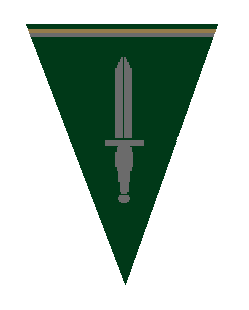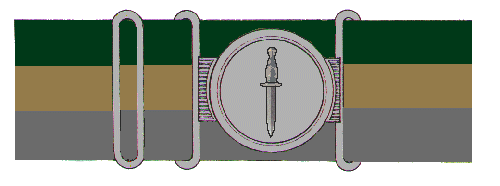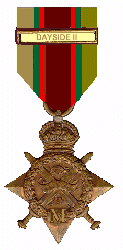| Orbat 'You'll have plenty to do Lieutenant Walshe.
I want you to put a Troop together, you've got carte
blanche and three weeks to do it in. You'll have to take
most of the recent crop of contract troopers but I'll
give you some transfers from the other Troops as well.
Your Troop Sergeant is coming across from the Sun Devils
and has a good head on her shoulders, use her as best you
can. Three weeks Lieutenant and I want them ready to take
on second line duties. Think you're up to it?'
Major A U Frost MC,
CO The Armoured Commando
21/12/02 - 0935
ZULU
The Armoured Commando is a powerful
fighting force that is just finding its feet. It has some
160 advanced Bowman A combat walkers in its inventory and
some 300 soldiers in its ranks. Working alongside other
elements of the CDF it represents an mobile, versatile
force in attack or defence.
The Commando is composed of an HQ
element, six CW troops, a reconnaissance troop and an
administrative wing. The unit usually operates in
conjunction with other elements of the CDF in order to
maximise its effectiveness. However due to the CW's
efficiency as a combat weapon on the Dayside the Commando
usually composes the spearhead of any operation. Troops
usually operate independently or with companies of CDF
infantry. If more than one CW Troop is required for an
operation either the senior Troop Commander takes command
or the Commando HQ will mobilise to run the operation.
Below: Organisation
of the Armoured Commando
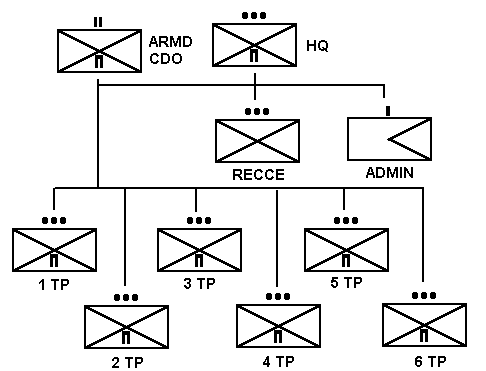
Armoured Commando HQ
The Armd Cdo has a relatively small HQ
section composed of a Tactical HQ and an Operations and
Intelligence Section.
The Tactical HQ is composed of a
command section and a close protection section. Major
Frost is well known for bringing his Tac HQ into close
proximity to the enemy when his soldiers are under fire.
Consequently his Tac HQ is composed of veteran soldiers
picked from the Troops of the Commando or from volunteers
from other Commonwealth units or experienced mercenaries.
The command section includes the CO, 2 i/c, Commando
Sergeant Major, CO's bodyguard and 2 communications
specialists. The close protection section is composed of
6 well trained and combat hardened soldiers.
The Ops and Int Section is split into
two elements, one located at a fixed or mobile forward
operations base and the other at the Duke of York's
Barracks in Rimview. Ops and Int is commanded by the
Commando's Ops Officer Captain Phillip Morris of the
Royal Wellon Regiment supported by the Int Officer,
Senior Rate Alice Llewellyn RSN. The section is
responsible for planning all major operations by the
Commando whilst ensuring deconfliction and proper support
from other units. It also has unrestricted access to the
new surveillance satellite network. When a Troop is on
operations a team from Ops and Int will always be in a
command centre.
CW Troop Organisation
The Combat Walker Troop's organisation
is based on that of British Army CW platoons. This
consists of 24 combat walkers, organised into three 6 CW
fighting sections, and a 6 CW command section. The
Section is sub-divided into three pairs, the lead pair is
usually commanded by a sergeant, the second by a corporal
and the last by a lance corporal. The remainder of the
section's personnel are private soldiers (although in the
Commando they are still called by the title used in their
previous regiment: Private, Gunner, Fusilier etc or if a
contract soldier 'Trooper').
The headquarters section is similarly
organised into three pairs. The troop commander is an
officer, either a Lieutenant or a Captain, many are
commissioned from the ranks. His second in command is an
experienced NCO, normally a colour-sergeant. The last NCO
in the headquarters element is a Electronic/Information
Warfare specialist, normally a corporal, who pilots a
Bowman C. The other soldiers in the section are normally
private soldiers.
Below: Organisation
of a CW Troop
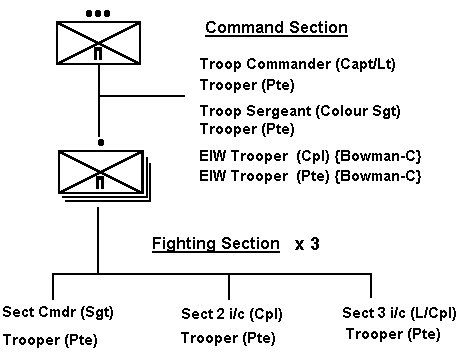
The Troop usually has between 4 and 6
additional pilots ('secondaries') who provide immediate
replacements and help with maintenance and local defence.
This number of secondaries is much lower than in their
British equivalent but reflects the lower level of
resources available to the Commando. The Troop also has a
Maintenance Section of eight soldiers dedicated to
keeping the unit's walkers up and running. The
commander's of the Troops have a great deal of latitude
in the running and training of their units. Consequently
standards differ between the different Troops and each
has its own style, strengths and weaknesses.
The six troops are numbered
sequentially but also have an official nickname. This
idea came from Major Frost who believed it would increase
unit recognition amongst the general population and
consequently boost unit morale. To some extent he has
been successful as a range of unofficial merchandise with
Troop crests on has appeared on the market stalls of
Rimview. Frost has also received interest from media
companies to cover his unit's exploits either in
documentary or fictionalised form.
Seconded British soldiers see this as
overly Americanised and glory hunting on Frost's part and
refuse to refer to the units by anything but their
numbers. The remainder of the unit is split however and
many of the younger, locally recruited soldiers use the
nicknames exclusively. Especially when on leave in
Rimview.
Troop callsigns are simpler than those
in use with the British. The fighting sections simply use
continuous numbers: 1 Section Commander is 11, his
wingman is 12, the section 2 i/c is 13, his wingman is
14, the section 3 i/c is 15 and his wingman is 16.
Whoever is in command at any given time adds an Alpha to
the end of his callsign e.g. usually the section
commander will have the callsign One One Alpha. The other
sections have callsigns starting with 21 and 31
respectively. However in the field on the Troop
chatter-net names or nicknames are often used.
The troop command section has similar
callsigns starting with 01 for the Troop Commander and
ending with 06. The Alpha tag is also used in the same
way within the command section. Armoured Commando troops
do not use changing callsign indicators, instead they
have a fixed indicator taken from the troop nickname. 1
Troop use LION, 2 Troop DEVIL, 3 Troop ADDER, 4 Troop
DEMON, 5 Troop KNIGHT, and 6 Troop REAPER. So Captain
Ishii of 4 Troop has the callsign DEMON ZERO ONE ALPHA.
No.1 Troop 'The Lion's Claws'
No.1 Troop was the first CDF CW unit to
be formed, originally as the 1st Combat Walker
Platoon. It was commanded and manned mostly by soldiers
seconded from the Provisional Battlegroup, but also
responsible for training native Craterans in CW
operations . Its commander was Sergeant Killean a CW
section commander from 6 PARA, who set about rigorously
training his new force. He was also willing to bring in
competent CW pilots from outside, setting a trend for the
Armoured Commando. As the 1st CW Platoon the
unit saw action in the Battle of Krak des Chevaliers,
where it beat off a mechanised Kafer counter-attack on
Holder's Breach.
The end of the Dayside Campaign saw 1st
CW Platoon renamed No.1 Troop and coming under command of
the newly formed Armoured Commando. Sergeant Killean
transferred to the CDF and was immediately commissioned
as a Captain, whilst several key players from the Troop
were sent on to help form No.3 Troop or returned to their
previous units.
No.1 Troop is named after the close
combat weapons designed by Private Löwe of the RGL who
was seconded to 1st CW Platoon (and later
killed at Krak des Chevaliers). The troopers are almost
all seconded British Army personnel or Crateran natives.
No.2 Troop 'Sun Devils'
No.2 Troop was originally organised as
the 2nd CW Platoon and became operational
mid-way through the Krak des Chevaliers battle, and only
saw action on outpost duties. Its original commander was Caporal-Chef
Marie Hichberger a highly experienced CW pilot of the
French I/8e Marine Paras, who had been
convalescing after being badly injured during the
Liberation in May. Hichberger proved an excellent trainer
and brought together a motley group of British and
Crateran soldiers and some volunteers from Joi together
in an effective unit very quickly.
At the end of the 1st
Dayside Campaign Hichberger returned to French service
and her second in command, Sergeant Williams (2 PARA)
took over as commander of No.2 Troop and was commissioned
into the CDF as a Lieutenant. Williams has sometimes been
described as a bully but his combat experience is
legendary and his Troop is highly competent. No.2 Troop
was most often deployed into the Dayside, and has built
up a strong bank of experience in the harsh conditions of
the area.
No.3 Troop 'Sand Adders'
No.3 Troop was formed immediately after
the creation of the Armoured Commando from a nucleus of
experience soldiers from No.1 Troop and included the
first major influx of Reformist Craterans into the ranks.
As many of these volunteers had previous experience with
mining walkers the training process was much quicker than
that of the previous units and was declared operational
after little more than a month. The Troop was deployed
into the Dayside, initially operating in the quiet
Eisen's Tower sector to free up the more experienced
units whilst learning the ropes.
3 Troop has been commanded since its
founding by Lieutenant Paul Devonish, a Lance Sergeant of
the Coldstream Guards who fought through the occupation
and a part of the Provisional Battlegroup in the 1st
Dayside Campaign. He was head-hunted to join the
Commandos once his battalion prepared to return to Earth,
and was commissioned on acceptance. Lt Devonish is an
effective leader with an understanding of the Crateran
mentality, however as a former Guardsmen he holds his
troop to the highest standards of turn out and
discipline.
No.4 Troop 'Dust Demons'
4 Troop was formed at the same time as
3 Troop except from a 2 Troop cadre. Like its sister unit
it originally had a large number of Reformist Craterans,
but also had a group of 4 pilots seconded from the
Coldstream Guards CW platoon. In recent months it has
gained a strong detachment of Japanese contract pilots
who have been concentrated into No. 3 Section.
The troop is led by Captain 'Mas'
Ishii, a former regular Japanese Army officer and a
veteran of the Central Asian War as well as fighting on
Joi and Crater. Ishii has utilised many facets of his
experience and Japanese doctrine in the training of his
Troop. The unit is well recognised as being the most
successful Troop in working with infantry forces as well
as being skilled at fighting in urban areas. Ishii is
well trusted by Major Frost and has great freedom of
action.
No.5 Troop 'Chevaliers du Kharst'
No.5 Troop was formed in the second
wave of expansion of the unit as it became clear to CDF
HQ that the 2nd Dayside Campaign was underway.
Luckily plans for the creation of two new troops had been
in the pipeline for some time and could be brought into
effect quickly. 5 Troop had a large proportion of
Contract soldiers as the resource of miner walker
experienced Craterans had largely dried up. A mixed bag
of mostly Francophone mercenaries were taken on which
allowed the unit to come into action quickly. However
many had little or no combat experience and discipline
was poor, several were killed or RTU'd.
The Troop has re-recruited taking on
new contract soldiers, a detachment of Beta Canum veteran
CW pilots from the Light Infantry and soldiers
transferred from the other Troops. The performance and
discipline has improved but its leadership is poor and
the Troop is often delegated to reserve defence tasks.
The commander is Captain Wallace Newberry of the Crater
Regiment. Newberry was a pre-War officer in the CDF and
has limited CW experience, however he has been promoted
to a position he is not ready to fill because of
political pressure.
The Duke of Crater and his backers in
the Consortium have made much capital about the absence
of Loyalist Crateran leaders in the Commando. Major Frost
hopes to nurse Newberry through another 4 months in
command before shunting him sideways. Newberry is a
likeable young man but lacks experience and is unwilling
to ask the advice of his NCOs. Consequently his troopers'
morale and confidence in him is at an all time low.
No.6 Troop 'Reapers'
No. 6 Troop is the sister troop of No.5
Troop. It also has a large proportion of Contract
soldiers, in this case an unusually large contingent of
ex-US Army personnel. These volunteers have mostly come
from the ranks of the 88th Shock Regiment and
had tired of endless exercises in the American
mid-western deserts. With desert experience and being
skilled CW operators this 10 strong group travelled to
Crater specifically to join the Commando. Their presence
has marked the character of the Troop and American
tactics and slang has entered the repertoire of the
Troop.
The Troop commander is Lieutenant
Amanda 'Blue' Walshe on Secondment from the Australian
Commandos. An expert in the use of CW in uncompromising
terrain she has been a welcome addition to the unit, a
penchant for unconventional tactics and a willingness to
delegate responsibility has forged an effective combat
troop. However her occasional criticism of Major Frost
combined with her outspoken backing for the Reformists
has caused her some problems. However her troop is well
trained and motivated and has had good results in its too
operations so far despite its relative youth.
Recce Troop
The Recce Troop was the result of one
of the first re-organisations of the Commando. It was
quickly realised that the Commando was often called out
to defend isolated communities but many times it was
found that the community had panicked and 'cried wolf'.
To cut back on needless deployments the Commando needed
roving liaison teams to act as its eyes and ears on the
Dayside. As well as reassuring local communities they
could gather their own information on Kafer activities
and ground conditions.
The first recruits were experienced
members of the local Crater Regiment detachments, mostly
native Daysiders experienced in living in the hash
conditions. These were supported by soldiers seconded
from regular units, mostly from the newly arrived Border
Regiment, who possessed more complete military patrolling
skills. Luckily this combination paid off with both sides
willing to learn from each other. Commanded by the
experienced Sergeant Karl Ramcke RGL, the Troop was
committed after a very limited period of build up
training.
The basic building block of the Troop
is the Patrol of which the unit possesses six. Each
Patrol has four men and two robust but lightly armed
Hover Rovers modified with long range fuel tanks. Each
patrol is given a certain area to cover and roams between
the isolated outposts reassuring the locals and gathering
information whilst sometimes being tasked to investigate
certain areas of concern noted by the satellite coverage.
The patrols can be gone for months on end and water
discipline and desert survival skills are paramount.
The Recce Troop has undeniably
increased the effectiveness of the Commando, reducing
unnecessary deployments and on several occasions setting
up elaborate ambushes. In addition they have proved very
useful in a hearts and minds role greatly increasing the
co-operation of the often suspicious Daysiders with the
CDF. The unit has just been reinforced with an advance
party of 8 soldiers from Wellon's Desert Reconnaissance
Force. These soldiers will be integrated into the patrols
to gain experience, a measure that will allow the
creation of a further two patrols.
Administration Wing
The Admin Wing is responsible for
routine administration, training and maintenance of the
Armoured Commando.
The Pay and Records Section consists of
two soldiers and two civilians under a Lance Corporal,
all the military staff are seconded from the CDF's
Adjutant General's Department. Its task is to take care
of all the routine administration of the unit and to
minimise the generation of distracting paperwork for the
commanders. This it achieves admirably. The Section often
has a more testing time ensuring the enrolment of some of
the more 'colourful' short contract soldiers against a
conservative CDF, but with the backing of the Governor
General resistance is usually short lived except in
remarkable cases.
The Training Troop is one of the most
troublesome aspects of the Armoured Commando. Put simply
it lacks the resources to properly train recruits,
however its staff make the best of a bad job. Commanded
by WO2 Alan Baker MM, from the Queen's Own Highlanders
and a veteran of the Raven Brigade, who has recently been
transferred to the unit, the Troop has two senior, four
junior instructors and four dilapidated Bowman A's and
two simulators. It is based out of the Duke of York's
Barracks in Rimview.
Maintenance Troop is in charge of
keeping the unit's 160 CW's in fighting condition.
Considering the often cannibalised and refurbished nature
of many of the machines this is not an easy task. The
Troop controls all of the Maintenance Sections attached
to the Troops as well as the Field Workshop which is
responsible for major repairs and overhauls. On top of
this the busy staff are often able to come up with some
effective field modifications. The unit is commanded by
Lt Liang.
|
